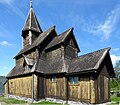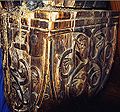Urnes stave church
| Urnes Stave Church | |
|---|---|
|
UNESCO world heritage |
|

|
|
| National territory: |
|
| Type: | Culture |
| Criteria : | (i) (ii) (iii) |
| Surface: | 0.21 ha |
| Reference No .: | 58 |
| UNESCO region : | Europe and North America |
| History of enrollment | |
| Enrollment: | 1979 ( session 3 ) |
The Urnes Stave Church in the small town Ornes on the eastern shore of the Lusterfjord , a branch of the Sognefjord in Norway . Its origins go back to the year 1100 and can therefore be described as the oldest stave church in the world. The building still preserved today dates from the 12th and 13th centuries.
It is above all its richly carved north portal, which is why it was added to the UNESCO World Heritage List in 1979. It combines traditional art of the Vikings , in which their older ideas such as the world tree Yggdrasil were reflected, and Romanesque designs . The carvings on the stave church are named for the Urnes style , the youngest style of the Nordic early Middle Ages ( Oseberg , Borre , Bredal , Jelling , Mammen), which all developed from the Germanic animal style .
Today the church belongs to the Fortidsminneforeningen antiquity association .
Movie
- The wood from the Yggdrasil tree. The stave church of Urnes Film in the series “Treasures of the World / Heritage of Humanity” by Andreas Christoph Schmidt. 2005, 15 minutes.
literature
- Signe Horn Fuglesang: Urnes (church). In: Reallexikon der Germanischen Altertumskunde (RGA). 2nd Edition. Volume 31, Walter de Gruyter, Berlin / New York 2006, ISBN 3-11-018386-2 , pp. 558-559.
photos
Stave church with a view of the Lusterfjord
Urnes Stave Church drawn by JCC Dahl , 1837
North portal ( Urnes style )
Cube capital of the pillars in the interior
See also
Web links
Coordinates: 61 ° 17 ′ 52.9 ″ N , 7 ° 19 ′ 19.1 ″ E








